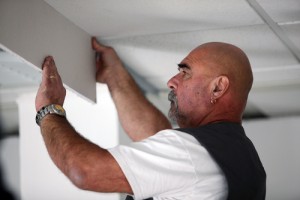 As new home construction is predicted to grow by 14 percent into 2016, drywall and plaster costs are expected to follow suit and rise by 7.5 percent per year. The continued recovery of residential construction is apparent in industry metrics like building permit data. In fact, drywall and plaster costs aren’t the only building materials to see increases on the horizon in the three-year time frame. Plywood and particle board costs will rise by 4.8 percent and 5.3 percent respectively. Medium density fiberboard is also going up, with anticipated increases topping 5 percent. The increase in raw copper costs is expected to continue boosting prices for electrical wiring as well.
As new home construction is predicted to grow by 14 percent into 2016, drywall and plaster costs are expected to follow suit and rise by 7.5 percent per year. The continued recovery of residential construction is apparent in industry metrics like building permit data. In fact, drywall and plaster costs aren’t the only building materials to see increases on the horizon in the three-year time frame. Plywood and particle board costs will rise by 4.8 percent and 5.3 percent respectively. Medium density fiberboard is also going up, with anticipated increases topping 5 percent. The increase in raw copper costs is expected to continue boosting prices for electrical wiring as well.
Why Are Drywall Costs Rising?
Even as the drywall-dependent residential construction market revives, as well as the rate of major home renovation projects, the price of drywall’s primary raw material—gypsum—is also on the increase. Because no practical replacement exists for gypsum in the manufacture of drywall, the home construction and remodeling industry is especially vulnerable to price fluctuations in this vital component.
Rising costs for the finished product are also matched by increases in the cost of installation. Again, increased demand for new construction is stressing the pool of available installers, making it more difficult for buyers of both the product and the service to bargain for better rates. Suppliers who previously negotiated prices are less motivated to as they see profit margins shrunk by the increased price of gypsum.
How Buyers Can React
Market analysts are advising high-volume buyers of both gypsum drywall and installation services to nail down price commitments as soon as possible rather than waiting for forecast increases to come true. Buyers are also advised to widen the extent of their search for both materials and installation in order to draw more competitive bids from a greater pool of suppliers.
Keeping abreast of swings in industry growth positions contractors and builders to recognize market changes, generate leads and target sales efforts appropriately. Building permit data compiled by Construction Monitor helps industry professionals stay up to speed on current industry trends as well as adjust to important downstream consequences like the increase in plaster and drywall costs.
Image via Shutterstock.com

Pingback: Pitfalls to Avoid When Hiring Subcontractors – Construction Monitor
Pingback: Understanding the Dangers of Silica Dust – Construction Monitor
I am really enjoying reading your well written article. It looks like you spend a lot of effort and time on your blog. I have bookmarked it and I am looking forward to reading new articles. Keep up the good work.
Nice Blog!! The content you have shared is very elaborative and informative. Thanks a lot for sharing such a great piece of knowledge with us.
I really read him carefully to know the necessary and important information attached to it. Thanks for providing tips on how to be more economical in choosing drywall that will suit their house.